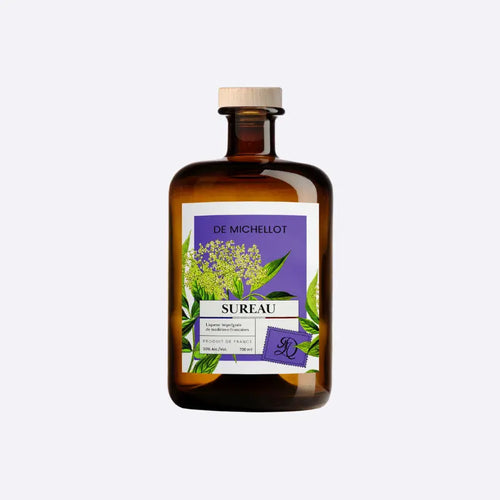Introduction
Powerful, aromatic and often mysterious, herbal liqueurs— or herbal liqueurs— are an integral part of European spiritual heritage.
Made from macerations of plants, roots and flowers, they are digestive, medicinal and tasty.
From the famous Chartreuse to artisanal Génépi, including the modern creations of De Michellot, herbal liqueurs perpetuate an ancestral art: that of transforming nature into flavor.
What is a herbal liqueur?
Herbal liqueursarea spirit drink made from aromatic and medicinal plantsmacerated in alcohol.
It can be sweet, bitter or floral, depending on the ingredients and the amount of sugar.
Legal definition and composition
According to French tradition, a liqueur must contain:
-
🌿 an agriculturalor grain alcohol,
-
🍃 natural extracts of plants, flowers or spices,
-
🍯added sugarto soften the bitterness.
Herbal liqueurs therefore combine botany and know-how, between aperitif and digestif.
A Brief History of Herbal Liqueurs
The first herbal liqueurs date back to medieval monasteries.
Herbalist monks used medicinal plants to concoct therapeutic elixirsintended to treat or strengthen the body.
Monastic origins
-
Chartreuse: made by Carthusian monks from a recipe from 1605.
-
Benedictine: created by the Benedictines in the 16th century in Fécamp.
-
Génépi: from Alpine traditions and mountain herbalists.
🌸 These recipes, passed down from generation to generation, have become symbols of French spirit culture.
Plants and ingredients of herbal liqueurs
Herbal liqueurs derive their richness from botanical diversity.
Each recipe combines dozens of herbs, flowers and roots to create a unique aromatic symphony.
The most used plants
-
🌼 Gentian: floral and digestive bitterness.
-
🌿 Verbena: lemony, light and soothing.
-
❄️ Mint: fresh, invigorating and minty.
-
🏔️ Génépi: floral, vegetal, emblematic of the Alps.
-
🍋 Anise and star anise: spicy and digestive notes.
-
🌸 Elderberry: floral and spring sweetness.
🌿 Each plant brings its character, color and complexity to the final liqueur.
Theiconic herbal liqueurs
Certain brands have left their mark on history through their expertise and their mystery.
Chartreuse
-
Developed by Carthusian monks.
-
Composed of 130 secret plants.
-
Available in green (55%), yellow (40%)or VEP (extended aging) versions.
World symbol of herbal liqueurs.
Benedictine
-
French liqueur with 27 plants and spices.
-
Sweet and spicy taste, perfect as a digestif.
Jägermeister
-
German liqueur with 56 plants.
-
Sweeter, often used in modern cocktails.
From Michellot: the French artisanal alternative
Michellot Plant Liqueursperpetuatethis tradition through an artisanal, natural and contemporary approach:
-
Gentian– elegant and floral bitterness.
-
Génépi– alpine and vegetal sweetness.
-
Verbena– lemony freshness.
-
Mint– distilled and refreshing.
Without artificial colors or flavors, they embody the French spirit of great vegetable liqueurs.
Taste profile of herbal liqueurs
Herbal liqueurs have a very wide aromatic palette:
-
🍃 Bitter and complex(gentian, genepi, green chartreuse).
-
🌸 Floral and sweet(verbena, elderberry, yellow chartreuse).
-
🌿Spicy and vegetal(anise, mint, sage, angelica).
Each liqueur tells a story: that of the terroir, the climate and the plants that compose it.
How to enjoy a herbal liqueur?
As an aperitif
Served chilled or on ice, it gently whets the appetite.
As a digestive
Pure, at room temperature, it reveals all its aromatic complexity.
In a cocktail
Herbal liqueurs are perfect for adding a vegetal and refined touch.
Some ideas:
-
Herbal Spritz: 4 cl of verbena liqueur + 8 cl of sparkling wine + sparkling water.
-
French Negroni: 3 cl of gin + 3 cl of red vermouth + 3 cl of De Michellot gentian.
-
Génépi Tonic: 4 cl of De Michellot génépi + 10 cl of tonic + lemon zest.
🍸 Simple, natural and elegant cocktails to rediscover French flavors.
Herbal liqueurs today: tradition and renaissance
Faced with the return of natural spirits and the search for authenticity, herbal liqueurs are experiencing a real revival.
Consumers are rediscovering the taste of real food, plants and craftsmanship.
🌿 It is in this spirit that De Michellotoffers its French artisanal herbal liqueurs, a combination of monastic tradition and modernity.
Conclusion
Herbal liqueursaremore than just drinks: they are liquid expressions of nature.
From Chartreuse to Gentian, they embody French history, botany and know-how.
🍃 DiscoverMichellot’s Plant Liqueurs— an invitation to travel between herbs, flowers and authenticity.
herbal liqueur, herbal liqueur, plant liqueur, French liqueur, artisanal liqueur, herbal digestif, chartreuse, genepi, verbena, gentian
